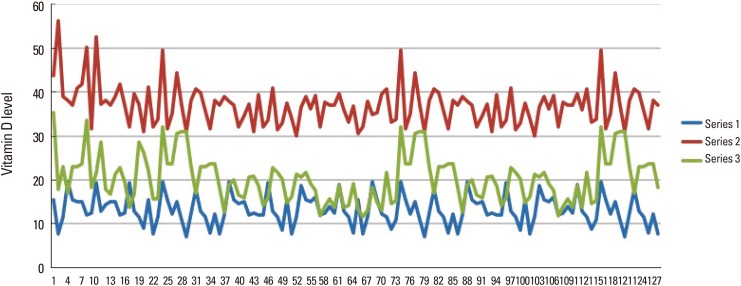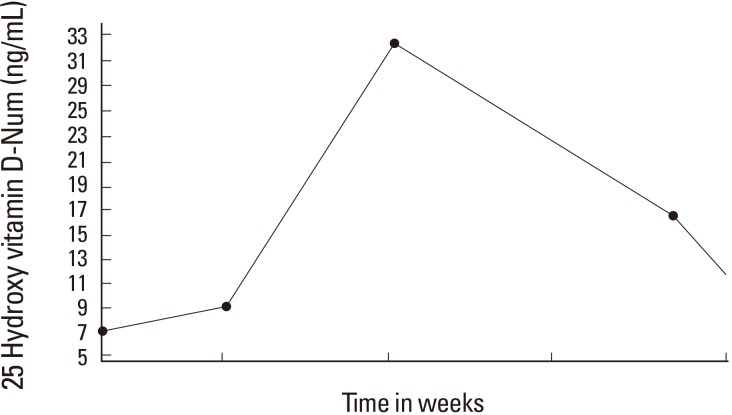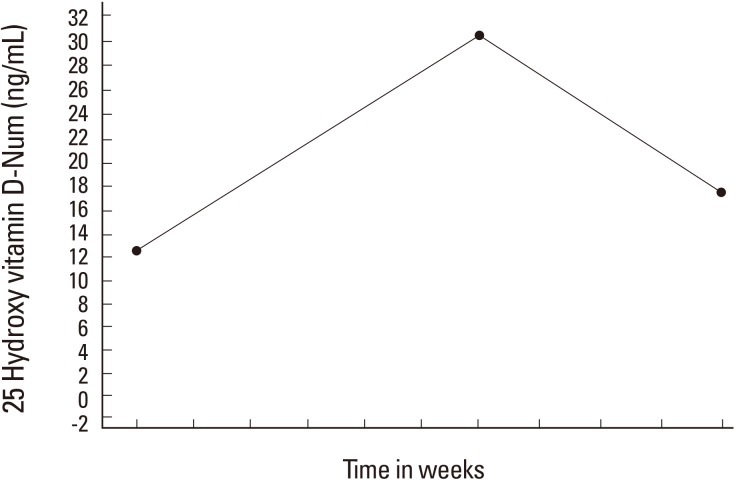J Bone Metab.
2018 Aug;25(3):161-164. 10.11005/jbm.2018.25.3.161.
Maintenance Dose of Vitamin D: How Much Is Enough?
- Affiliations
-
- 1Department of Orthopaedic Surgery, King Fahd Hospital of the University, Imam AbdulRahman Bin Faisal University, Al-Khobar, Saudi Arabia. drsadat@hotmail.com
- 2Department of Obstetrics and Gynecology, King Fahd Hospital of the University, Imam AbdulRahman Bin Faisal University, Al-Khobar, Saudi Arabia.
- KMID: 2419843
- DOI: http://doi.org/10.11005/jbm.2018.25.3.161
Abstract
- BACKGROUND
It is still unclear the ideal vitamin D dosage once the deficiency and insufficiency is treated. Once deficiency was corrected we prospectively treated patients with 2,000 IU of vitamin D3 to check whether this dosage is enough to keep them above the 30 ng/mL of 25-hydroxy-vitamin D (25[OH]D).
METHODS
One hundred and thirty-five Saudi Arabian men and women treatment naïve for the vitamin D deficiency and insufficiency were part of this study. History and clinical examination were done to rule out any metabolic bone disease. Weight and height was taken to calculate the body mass index (BMI). Patients who were vitamin D deficient (≥30 ng/mL), a standard treatment of 50,000 IU of vitamin D3 weekly for 3 months, a blood test for the vitamin D levels at the end of 3 months, maintenance dose of 2,000 IU of vitamin D3 for 3 months and a third blood sample after 3 months.
RESULTS
The data for 128 patients was available for analysis. The average age was 44.95±12.97 years with the mean BMI of 29.60±2.59 kg/m2. The baseline 25(OH)D level was 13.16±3.30 ng/mL. The increase in the level of 25(OH)D on 50,000 IU weekly was significant from 13.16±3.3 ng/mL to 36.97±4.67 ng/mL (P < 0.001) and then 2,000 IU daily for next 3 months, the level of 25(OH)D dropped top 20.38±5.42 ng/mL (P < 0.001).
CONCLUSIONS
Our study indicates that the maintenance dose of 2,000 IU of vitamin D is not enough for patients to keep the 25(OH)D levels above 30 ng/mL.
MeSH Terms
Figure
Reference
-
1. Autier P, Boniol M, Pizot C, et al. Vitamin D status and ill health: a systematic review. Lancet Diabetes Endocrinol. 2014; 2:76–89. PMID: 24622671.
Article2. Holick MF. Vitamin D: a millenium perspective. J Cell Biochem. 2003; 88:296–307. PMID: 12520530.
Article3. Holick MF. Resurrection of vitamin D deficiency and rickets. J Clin Invest. 2006; 116:2062–2072. PMID: 16886050.
Article4. Ross AC, Manson JE, Abrams SA, et al. The 2011 report on dietary reference intakes for calcium and vitamin D from the Institute of Medicine: what clinicians need to know. J Clin Endocrinol Metab. 2011; 96:53–58. PMID: 21118827.5. Institute of Medicine. Dietary reference intakes for calcium and vitamin D. Washington, DC: The National Academies Press;2011.6. Vitamin D Council. Vitamin D. 2018. cited by 2018 March 1. Available from: https://www.vitamindcouncil.org/.7. Holick MF, Binkley NC, Bischoff-Ferrari HA, et al. Evaluation, treatment, and prevention of vitamin D deficiency: an Endocrine Society clinical practice guideline. J Clin Endocrinol Metab. 2011; 96:1911–1930. PMID: 21646368.
Article8. Kennel KA, Drake MT, Hurley DL. Vitamin D deficiency in adults: when to test and how to treat. Mayo Clin Proc. 2010; 85:752–757. quiz 7-8. PMID: 20675513.
Article9. Osborn J, Germann A, St Anna L. Clinical inquiries. Which regimen treats vitamin D deficiency most effectively? J Fam Pract. 2011; 60:682–683. PMID: 22049353.10. Greater Manchester Medicines Management Group. Treatment of vitamin D deficiency and insufficiency in adults. 2016. cited by 2016 March 1. Available from: http://gmmmg.nhs.uk/docs/nts/NTS-Recommendation-on-Vitamin-D-deficiency-and-insufficiency-adults.pdf.11. Pludowski P, Holick MF, Grant WB, et al. Vitamin D supplementation guidelines. J Steroid Biochem Mol Biol. 2018; 175:125–135. PMID: 28216084.
Article12. Haq A, Wimalawansa SJ, Pludowski P, et al. Clinical practice guidelines for vitamin D in the United Arab Emirates. J Steroid Biochem Mol Biol. 2018; 175:4–11. PMID: 27693095.
Article13. Choi HS, Min YK, Byun DW, et al. Korean society for bone and mineral research task force report: perspectives on intermittent high-dose vitamin D supplementation. J Bone Metab. 2017; 24:141–145. PMID: 28955689.
Article14. Sadat-Ali M, Al Elq A, Al-Farhan M, et al. Fortification with vitamin D: comparative study in the Saudi Arabian and US markets. J Family Community Med. 2013; 20:49–52. PMID: 23723731.
Article15. Food and Drug Administration. Food additives permitted for direct addition to food for human consumption; Vitamin D2. Fed Regist. 2016; 81:46578–46582.
- Full Text Links
- Actions
-
Cited
- CITED
-
- Close
- Share
- Similar articles
-
- Impact of ABCB1 C3435T Polymorphism on Treatment Response of Vitamin K Antagonists: A Systematic Review and Meta-analysis
- Preventive Effect of Single Dose Vitamin K for the Late Hemorrhagic Disease of Infancy
- The effect of metformin on vitamin B12 level in pediatric patients
- Increment in vitamin D level and bone mineral accrual in children with vitamin D deficiency
- Vitamin D regulation of adipogenesis and adipose tissue functions




